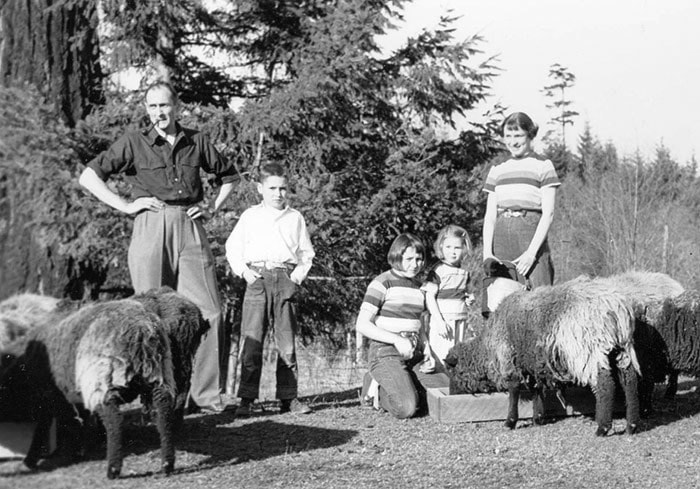Catherine Gilbert
Museum at Campbell River
Roderick Haig-Brown was known to many people as a man of many facets. While in Campbell River, he served as a lay judge, and was a writer, fisherman, conservationist, husband and father; and although he resided on an acreage, was admittedly not a farmer.
Yet the property that he and his wife Ann purchased in 1934 in Campbell River by the river eventually evolved into a small sort of farm – with a large vegetable garden, a milk cow named Heather and calf called Primrose, as well as sheep. Roderick made the decision that he should tackle creating a vegetable garden, even though he knew virtually nothing about growing plants and relied on Sudell’s Gardening Encyclopedia. He gamely attempted to grow various vegetables and lists among the most satisfying of his achievements; his success in growing the Sweet Pea. It must have become evident at some point however, that his gardening virtuosity and the needs of the family somehow didn’t mesh, as at one point he abandoned his aspirations and allowed Ann to take over. This, he wrote in Measure of the Year, seemed sensible as Ann was the chief cook of the family.
“Fifteen years ago, Ann was a city girl. She says she has the heart of a peasant. Sometime during the war years, Ann took over the vegetable garden and she has run it ever since, to the great good of the household. Her finest crops are beans, peas, tomatoes and corn and these set the times of her summer. But among them are all the other vegetables, grown… with a housewife’s careful sense of the year’s needs.”
Eventually, all the family’s needs for produce were satisfied by what was grown in the garden. Other areas of the property however, were given a different type of attention; with a sense of what would be aesthetically pleasing. Roderick said of himself: “I attend to the frivolous flowers and trees.” In fact, the Haig-Browns eventually planted several trees: ash, beeches, chestnuts, crabapples, dogwoods, lindens, maples, oak, walnuts, and willows, and had a fruit tree orchard.
Roderick’s domain was also the lawn. He removed a wooden tennis court that was located by the river, and used horses to plow and flatten the area, then put in grass. Automatic sprinklers were installed, at a time when no one else had them. The lawn provided a setting for recreation and one of the family’s favourite pastimes was to play croquet on the lawn, a tradition carried on by the Museum at Campbell River as a summer program.
The eventual look of the property was profoundly influenced by a trip the Haig-Brown’s took to Italy. Ann fell in love with Italian gardens and upon their return, a terrace was put in, as well as a pond. Grapes known as Campbell’s Early, a concord variety, were planted in the covered porch on the east side of the house. A formal garden was put in and Ann’s tastes were very specific. According to Marcy Prior, who began as gardener five years before Ann passed away, Ann decreed that “Pots had to be terracotta, and they had to be Italian terracotta.”
When asked how she got started, Marcy explained that she had been working at a local nursery, when a co-worker, who had been Ann’s gardener, was unable to continue and asked Marcy if she would take over. As it only involved one day a week, Marcy felt she could find a way to make it work for her. That was almost 30 years ago, and Marcy now looks after the property on behalf of the Museum at Campbell River, which oversees the Haig-Brown House and site. Marcy came highly recommended to any future managers of the property. In a position paper Ann had written to the Kingfisher Creek Society in 1988, Ann declared: “If it is a matter of carrying on the Haig-Brown Heritage, she [Marcy Prior] is the obvious person to do it.”
In the time Marcy has been the site’s gardener, the vegetable garden, which had been just a small patch at the front of the house when she started, was moved back to its original location. As well, the trees in the orchard had to be cut down, as so many were broken and fallen, and had been badly pruned by a chainsaw at one time. It was decided to take a graft from the original heritage apple trees and have them regrown by specialists Denman Island Heritage Apples Trees. The young trees were planted two years ago, and have even produced an apple! Marcy is concerned however, that it will be difficult to keep the bears away from them, as the bears have always wandered the property in search of food and will always continue to do so.
One of the best days for visitors to enjoy the property is when the Museum holds the Haig-Brown Festival, being held on Sunday from noon to 4 p.m. There are numerous displays that celebrate conservation, fishing and literature, as well as stewardship awards, music and Haig-Brown readings. It provides an excellent time to wander the grounds.
